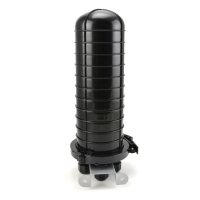What is fiber optic splice closure? fiber optic splice closure is a passive component widely used in fiber optic cable management. fiber optic splice closures, sometimes called as joint closures, are applied to connect and store optical fibers safely either in the outside plant or indoor buildings. They can provide protection for the fiber joint and the fiber cables, since they have excellent mechanical strength and strong out shell, which ensure the joints not be damaged by the hostile environment.
As we have known, fiber optic splice closures play an important role in optical cable network. And according to the environment and working area, fiber optic network operators specify the requirements for the joint closures. However, there are certain common requirements that every fiber optic splice closure shall meet. Here are these requirements.
A fiber optic splice closure shall be capable of accepting any fiber optic cable as specified in the tender document. Therefore, it is necessary to find out the cable type before deciding on the closure type. The design of fiber optic splice closures changes with the application areas. Thus, a fiber optic splice closure for aerial will have different design from that used for underground application.
Number of Ports, also known as the cable entrance capacity. The number of ports in a fiber optic splice closure reflects its capacity to handle the number of cables. The cable entrance capacity of a fiber optic splice closure refers to the number of ports available for terminating cable within the closure. The number of ports provided in a closure depends on factors such as the network capacity and number of cables employed in the network. Usually, in an attempt to reduce the physical size of high-capacity closures, smaller ports shall be utilized for branch cables and drop cables.
Additional capacity is retained by closure manufacturers. For example, if the specification requirement is 48 fibers, manufacturers often provide enough capacity to deal with 60 fibers.
The cable termination system should be designed to provide sufficient mechanical strength between the cable and closure to ensure its performance throughout the lifetime. The materials used for fiber optic splice closures shall also be capable of minimizing or negating the effects of relative motion between cable components, because the materials used in optical fibers are easy to thermal expansion and contraction.
Proper bonding and grounding of conductive elements of the optical network shall be provided for the safe deployment and operation of the network.
Aerial fiber optic closures may need to hang on the messenger wire depending on the network configuration. Or they may be attached to the pole. In both cases, extra hardware is required along with the closures. The hardware to attach and secure should be able to bear wear and tear and also environmental stresses.
Generally, there are two types of closures to face different situations: vertical type and horizontal type.
Vertical splice closure is usually dome size out body. So sometimes it is named as dome fiber splice closure. Their features are reliable performance and low cost. And they are typically designed for buried applications.

Horizontal type closure is like a flat or cylindrical case. They provide space and protection for fiber optic cable splicing and joint. Most horizontal fiber optic splice closure can fit hundreds of fiber connection. They are designed to be waterproof and dust proof. They have good adaptability and compression resistance, for they are commonly made of high tensile construction plastic. Horizontal optical closures have more use range than vertical fiber optic closures.

Splice closures provide room for splicing outdoor fiber cables together. Fiber optic splice closures can be installed on steel cables, in pipelines and on poles. They can provide a reliable sealing performance and meet environmental conditions. The existing variable kinds of fiber optic splice closures are suitable for different applications. For instance, optical splicing closure can be used outdoor, underground, and even underwater. Hence, fiber optic closures are commonly used in telecommunications, CATV (Community Antenna Television) cable, optical cable network systems.
In summary, in the complex cabling systems, fiber optic closures can offer strong protection for your optical network. If you want to extend the life of your fiber cables and save additional spending, you cannot miss fiber optic closures.